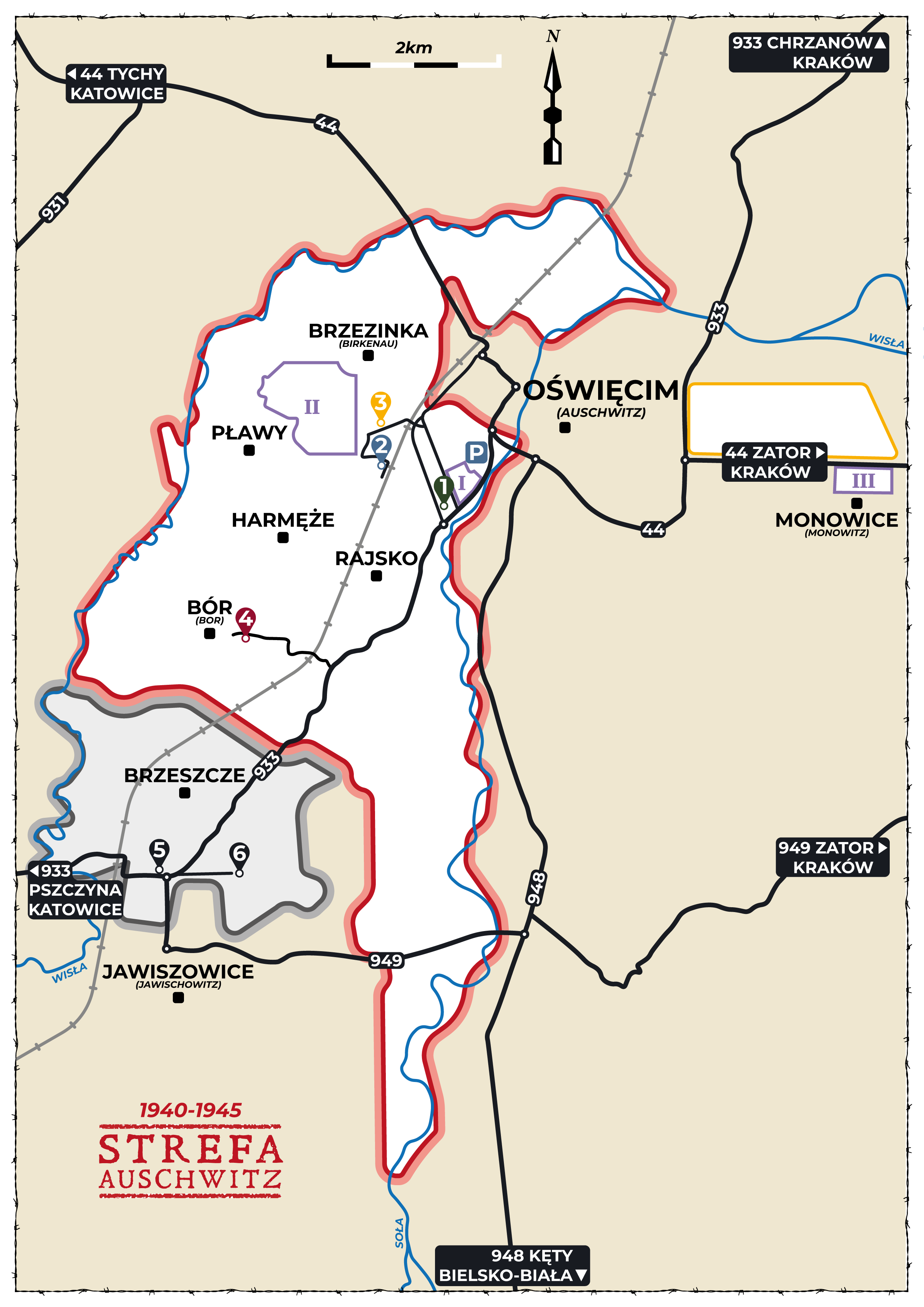

E-GUIDE
"Camp Kitchen/Canteen" - wooden building with a barracks-like structure, built using the forced labour of camp prisoners in years 1941-1942. Until liberation of KL Auschwitz in January of 1945, it served as a kitchen, canteen, mess-hall for SS privates and officers, theater and cinema hall with a full-sized stage. Performances, plays, concerts, cabarets and boxing fights were held there, all involving prisoners. The large hall could accomodate up to 1500 - 2000 people. The SS created a special prisoner commando to serve in this building. The prisoners had to work in the kitchen, serve in the halls and entertain the SS men by performing on stage. An object inextricably linked with martyrdom and prisoners of the former German Nazi concentration and extermination camp KL Auschwitz-Birkenau. It was build using their hands, and during its operation as a camp it was a place of their slave labor.
It is one of the biggest wooden buildings remaining from the German Nazi concentration and extermination camp complex in Europe. It has over 17 000 cubic meters. It's an enormous ground floor, huge basements and a technical floor with a projector room. The building has it's own original railway ramp and active tracks.
This track was layed down in the 1920s and served as a and served as an access way to the pre-war tobacco monopoly buildings standing in the Canteen's surroundings. On june 14, 1940 the first German transport train entered those tracks, full of Polish Political Prisoners from the prison in Tarnów. In years 1940-1943 the canteen's ramp was also used to unload some of the German deportation transport trains full of people sent to the camps from all of the German-occupied Europe.
The Canteen building stands only 400 meters in a straight line from the „Arbeit Macht Frei” gate of the KL Auschwitz concentration and extermination camp.
This unique building is currently undergoing conservation work, the large wing is dismantled. Due to ongoing works, you can enter the building only within the main entrance hall, where an exhibition about the SS crew and the functioning of the SS canteen is placed. After visiting the hall, head along the canteen towards the railway ramp, where you can enter an original pre-war German cattle wagon, in which an exhibition about deportation transports is placed. On the railway ramp, you can see original items from deportation transports found in the large canteen garbage dump.
Please note: the website is currently still under development and the descriptions are a subject to change.
It is a huge brick building built with forced slave labor of prisoners in 1942-1943. A 250-meter-long structure containing 10 halls with an area of almost 1,000 m2 each. This building was used to store mainly potatoes, but also turnips, onions, carrots, beets, etc. All these agricultural produce were obtained with free, forced labor of prisoners from the huge area of almost 50 km2 of the camp zone created by the displacement of the surrounding villages and the takeover of the cultivation and breeding area by the camp SS authorities. It is difficult to determine how many tons of vegetables were stored at one time, but, similarly to the KRAUTSILOS, most of the agricultural produce was intended by the SS camp authorities for export and sale to the Reich.
A brick building built with forced slave labor of prisoners in 1942-1943. Inside the building there are three lines of tubs/tanks for pickling cabbage, each with 10 tubs, below floor level. All tanks together had a total capacity of 300m3. Assuming a cubic meter of cabbage weighs a ton, that's approximately 300 tons of sauerkraut. This huge amount of sauerkraut was not intended by the camp authorities for the needs of the camp, but for external sale to the Reich. The prisoners had to prepare the fields, plant them, and then harvest the crops and take them to the warehouses using forced, free labor. It is the only such building in the system of former German concentration camps in Europe. Its uniqueness is also emphasized by the fact that, despite its provenance and inextricable connection with martyrdom and the Holocaust, it is also a technical monument.
This prewar railway junction, which the Germans used to bring people in forced deportation transports from all over German-occupied Europe. These are a few siding tracks. Apart from the tracks, there was no unloading infrastructure here. People were unloaded directly from the height of the carriages onto the gravel next to the tracks. In the period from spring 1942 to May 1944, about half a million Jews were brought here, men, women and children, coming from all over German-occupied Europe, as well as from remote states and territories of the Reich itself, and several tens of thousands of Poles, over 20,000 Roma and Sinti, as well as representatives of other nationalities. Immediately after unloading, the SS men waiting here began the selection of people brought there. All those, who were able to march, were escorted on foot to the camp by SS men. Also those, who were intended for immediate extermination, which most often constituted 70-75% of the newly arrived transport. There were also trucks here that were intended to transport people sentenced to immediate death and unable to walk to the camp to the gas chambers. The remaining trucks were used to pack belongings and luggage brought in deportation transports. All the looted property was transported to the so-called "Canada" warehouses.
Currently, the Food Storage Facilities have been preserved in the form of a roof-less ruins, conservation works are being carried out and a project to rebuild and restore them to the condition from 1943 is being initiated. Next to the KRAUTSILOS building, you can see an outdoor exhibition about the functioning of the building. In the KARTOFFELNLAGERHALLEN building, in the first box, there are two exhibitions, one about the functioning of the building and the other about deportation transports.
Please note: the website is currently still under development and the descriptions are a subject to change.
From the beginning of the constructio in April 1941, the prisoners of the KL Auschwitz concentration camp are taking part in the construction of the chemical processing plant. Initially, the prisoners were transported to the construction site by trucks, later on foot or by rail. After the typhus epidemic outbreak in the main camp, the camp authorities decided to establish the Monowitz subcamp, for which the management of the IG Farben concern allocated part of the area right next to the construction site. Discover behind the scenes of the biggest chemical processing plant and the third biggest concentration camp of the KL Auschwitz-Birkenau complex.
Please note: the website is currently still under development and the descriptions are a subject to change.
The one and only external penal company in history of the KL Auschwitz-Birkenau concentration camp complex. Placed only 5km away from KL Auschwitz-Birkenau, it was a part of th KL Auschwitz-Bor/Budy subcamp. Estabilished in June 1942 in a former school building. In October of the same year, the site of the murder of almost ninety French Jewish women at the hands of six German female prisoners.
On the premises of the former sub-camp there are also preserved foundations of the camp bathhouse-latrine, a digital reconstruction of the building is being prepared, and the current state of work can be seen<HERE>.
Please note: the website is currently still under development and the descriptions are a subject to change.
Created in 1942 to accomodate the needs of the near hard coal mine. According to the prisioners, considered to be the hardest cubcamp of the KL Auschwitz-Birkenau complex In 1944 it reached a peak prisoner count of nearly two and a half thousands, including children.
Please note: the website is currently still under development and the descriptions are a subject to change.
